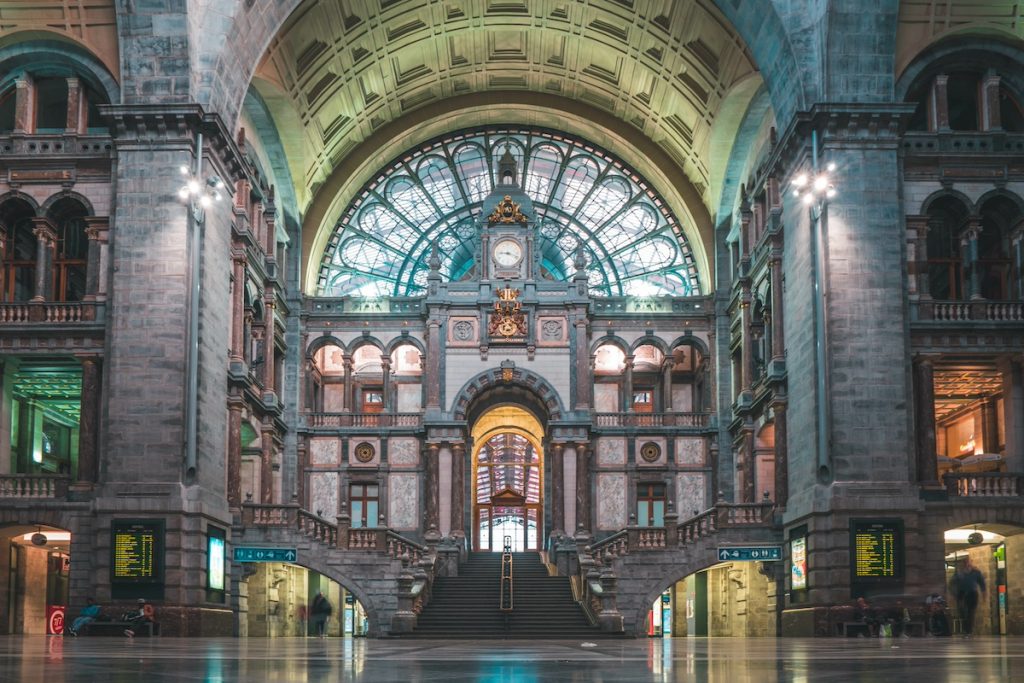Antwerp Central Station, often hailed as one of the most beautiful train stations in the world, is a masterpiece of architectural design and a symbol of Belgium’s rich history. Opened in 1905, this iconic station has served as a gateway to the city for over a century, welcoming travelers with its grandiose design and timeless elegance. The station is not just a transportation hub; it is a living testament to the cultural and industrial heritage of Antwerp and Belgium.
Architectural Marvel
Design and Construction
Antwerp Central Station was designed by the Belgian architect Louis Delacenserie, who combined various architectural styles to create a structure of unparalleled grandeur. The station’s main hall is an impressive example of eclectic architecture, blending elements of neo-Renaissance, Baroque, and Art Nouveau. The vast dome, which rises 75 meters above the main hall, is one of the station’s most striking features, symbolizing the height of Belgium’s industrial prowess at the turn of the 20th century.
Materials and Craftsmanship
The station’s construction utilized the finest materials available at the time, including marble, stone, and iron. The detailed craftsmanship is evident in every corner of the station, from the ornate facades and intricate carvings to the grand staircase and elegant clock tower. These elements reflect the ambition of the designers and builders to create not just a functional space, but a work of art that would stand the test of time.
Historical Significance
A Symbol of Progress
When Antwerp Central Station opened its doors in 1905, it was more than just a transportation hub; it was a symbol of progress and modernity. The station was part of a broader movement to modernize Antwerp’s infrastructure, facilitating trade and travel during a period of rapid industrialization. The construction of the station coincided with the expansion of the Belgian railway network, which played a crucial role in the country’s economic development.
World War II and Aftermath
The station has witnessed significant historical events, including the turmoil of World War II. Despite suffering damage during the war, the station was quickly restored, underscoring its importance to the city and its resilience in the face of adversity. In the post-war era, Antwerp Central Station continued to serve as a vital link between Belgium and the rest of Europe, adapting to the changing needs of travelers and the growing demands of international rail traffic.
Modernization and Preservation
21st-Century Renovations
In the early 2000s, Antwerp Central Station underwent extensive renovations to modernize its facilities while preserving its historical character. The renovation project, completed in 2007, included the addition of new train platforms, a modern underground level, and improved passenger amenities. The station’s original architectural features were carefully restored, ensuring that the station retained its historical charm while meeting the needs of contemporary travelers.
Cultural Landmark
Today, Antwerp Central Station is not only a functioning railway station but also a cultural landmark. It has been recognized as a protected monument and continues to attract visitors from around the world who come to admire its architectural beauty. The station frequently hosts cultural events, exhibitions, and tours, further cementing its status as a key part of Antwerp’s cultural and historical landscape.
Conclusion
Antwerp Central Station stands as a testament to Belgium’s rich heritage, combining architectural splendor with historical significance. From its grand design and use of luxurious materials to its role in shaping the city’s history, the station is a symbol of Antwerp’s enduring legacy. As it continues to serve travelers and visitors alike, Antwerp Central Station remains a beacon of the city’s past, present, and future.


